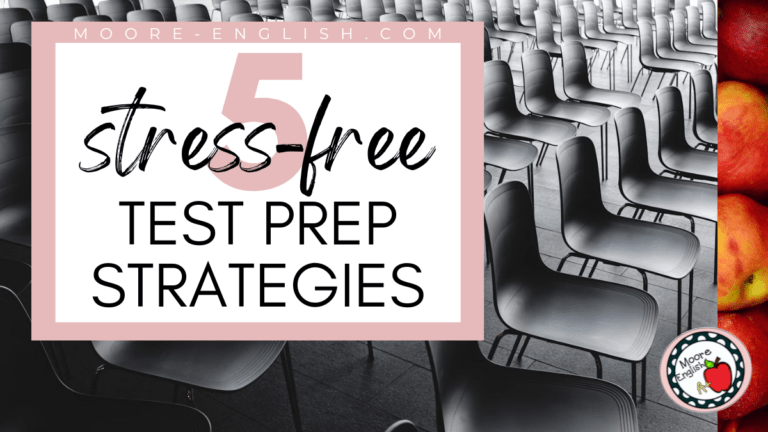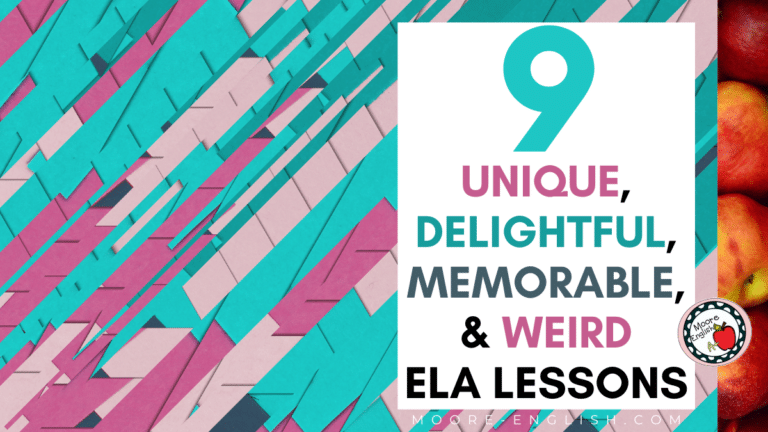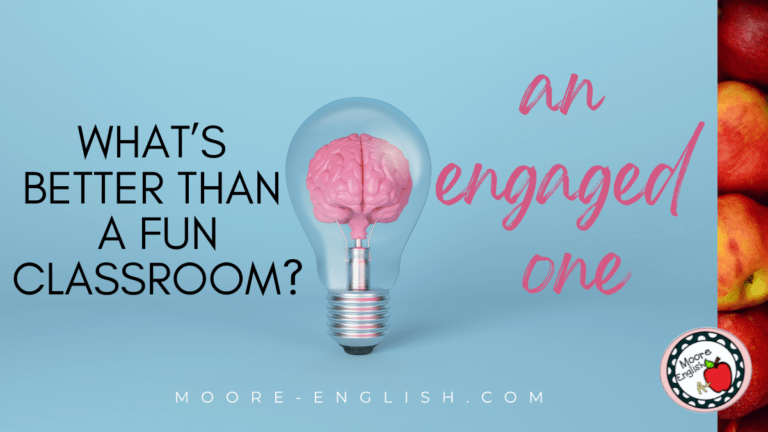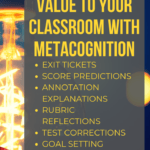Two weeks ago, I shared some of the details I add to my lesson plans. Bloom’s levels are one of the elements I mark in my lesson plans.
However, my understanding of Bloom’s changed after I read this article from Julie Stern at Share My Lesson. The article dives into updates to the familiar Bloom’s pyramid. But it does an especially good job describing updates to the knowledge level. In fact, the article describes knowledge as procedural, factual, conceptual, or metacognitive.
For me, this last element–metacognitive knowledge–has had the greatest impact on my classroom. Research suggests that metacognition, or thinking about thinking, can empower students. And this helps students know themselves as learners and thinkers. So today I wanted to share opportunities for including metacognitive thinking in your classroom.

This post this post may contain affiliate links. Please read the Terms of Use.
Metacognition and Formative Assessment
Exit tickets: To start, metacognition needn’t be elaborate or complex. In fact, keeping the stakes low can help students buy in to metacognitive thinking. And for those skeptical of metacognition, an efficient exit ticket can help waylay concerns about metacognition taking away from curriculum. (In response to this concern, I would explain that metacognition enhances curriculum.) After a lesson, using exit tickets (one of my goals this year) can help students reflect on what they learned. First, consider what worked during the lesson? And what didn’t work? Check out my favorite exit tickets.
Score predictions: Another quick way to help students think about their thinking is to ask students to predict their scores. While scores are not the end-all, they are (right or wrong) a classroom reality. Plus, students are used to scores. In the classroom, I use this strategy most often with weekly grammar quizzes. Over the year, students become accustomed to the quizzes. As a result, students can more readily predict what score they will earn. In other words, they are starting to know themselves as learners. In fact, score predictions are one version of self-reported grades. And self-reported grades have the second-largest effect size in terms of impacting student learning. As students predict more often, teachers can add another layer to deepen metacognition. For example, ask students to explain why they think they earned x score.
Explaining annotation: At the start of the year, I added a new metacognitive strategy to my instruction. In ELA, students spend a lot of time annotating text. First, we annotate poetry. Then, we annotate informational texts. And we annotate everything in between. One way to help students think through a text is to have them try to explain their annotations. To begin, ask why did you underline this? Or why did you draw an arrow here? To keep the conversations low stakes, students can talk through their annotations peer to peer. Or students can even write to describe their annotation process. Get more great ideas for annotation.
Metacognition and Summative Assessment
Rubric reflections: As ELA teachers, we know that writing is a process. As my students move through the writing process, we constantly refer to the rubric. Sometimes we close read the rubric. Then, we use the rubric to score exemplar papers. And then students use the rubric to evaluate themselves as they work through different parts of the writing process. Since rubrics can be overwhelming, this allows students to get familiar with the rubric while also constantly engaging in metacognition. This process keeps students continually considering how their writing is going. And it helps them figure out what they need to do in order to get their writing to where they want it to be. Check out my favorite writing rubric.
Test corrections: If asked, most teachers would probably eliminate a lot of major test events. As teachers, we know that high-stakes testing can have some serious mental and emotional stakes for students. However, most teachers also work in systems that require a certain amount of testing. Sometimes it’s benchmark testing, interim testing, unit tests, or standardized test. To combat this, teachers might consider offering test corrections or revisions.
Personally, I prefer test revisions or corrections to full-blown test retakes. For one, revisions/corrections afford students the opportunity to explain their thinking.
Here’s the form I use for students interested in test revisions. Note that the form works for 9-12 and may be too stringent or lenient for your system. This form is free, so grab it today!
Professional Metacognition
What I expect of my students I also expect of myself. For this reason, I believe metacognition has benefits for professionals, too! Here’s two ways to bring metacognition into your professional development:
Goal setting: Developing professional goals is key to my professional growth. (You can read past goals here, here, and here.) However, I’m also an advocate of writing down and explaining my goals. Why are these goals valuable? What struggles do I anticipate? What resources are available? Writing down my goals is one of the reasons I stated Moore English. And this kind of explicit metacognition makes for more intentional teaching.
Unit feedback: At the end of a unit, I ask my students for feedback. When students provide feedback, it helps me understand their needs and thinking. Once I have their feedback, I can think through more classroom decisions. In other words, I think about my thinking as a teacher. What classroom moves proved most effective? Which ones proved most challenging? And which were intentions? Answering these questions helps me be more aware of my thinking even as I’m teaching. Get my free student feedback form.

Photo by Johannes Plenio on Unsplash











